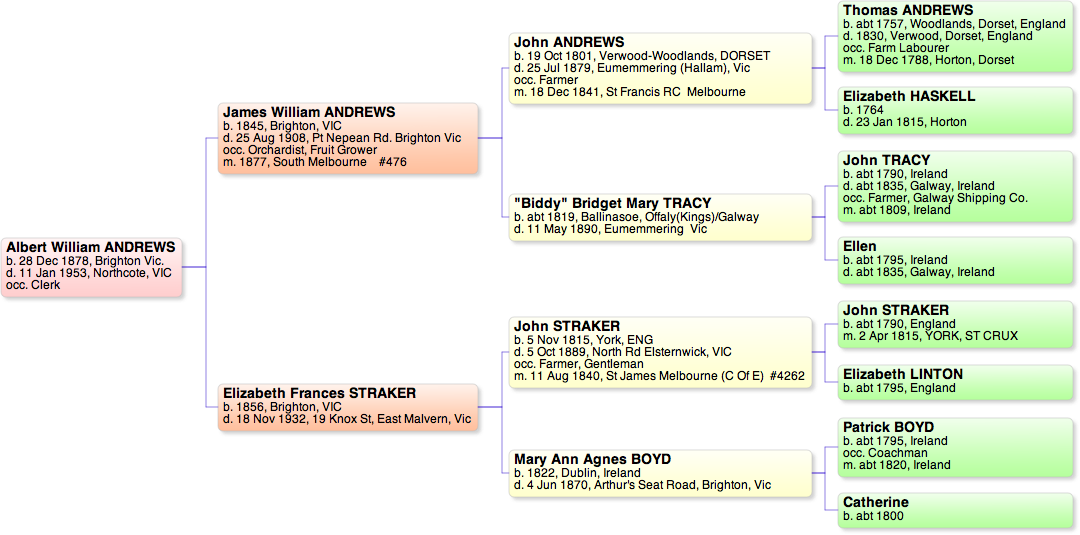
| The earliest
record of my Andrews ancestors is the marriage of Thomas
Andrews to Elizabeth Haskell in Horton,
Dorset, in 1788. The parish register notes that they
were both "of Woodlands", an adjacent hamlet. Later the
family lived in Verwood and Romford.. This area of
Dorset boarders Wiltshire and Hampshire. The occupations
mentioned are gardener, farmer, ploughman, farm labourer
and later brick maker. Elizabeth's family came from
Cranborne, nearby Today Horton and Woodlands are little more than intersections on country roads with a few scattered houses. Verwood has seen rapid growth this century, following the arrival of the railway, and is a sizable town. Cranborne still looks somewhat as it may have in the late 1800’s. Cranborne is the site of a monastery, founded in 980 and said to be the oldest in the England. The countryside is gently rolling hills; and the villages are a few hours walk away. Dorset has, over the years, been occupied by the Britons, Celts, Romans, Saxons, Angles, Jutes, Danes, Vikings and Normans, etc. I guess we are a blend of all of these. The Andrews name is common in the UK and is derived from the apostle Andrew, the patron saint of Scotland. Andrews (and Anderson) usually mean the son of Andrew. There are thousands of Andrews marriages and christenings in parish records back to the 1500s. Several Andrews families feature in the Verwood area however I have difficulty identifing the parents of Thomas. (A possibility mentioned to me is "......Thomas Andrews baptised Gussage 10-11-1754 to a Thomas and Mary Andrews.". thanks Rita, Sept 2007) Elizabeth's parents were Joseph Haskell & Elizabeth Amey. The Haskell name has a 500 year history in Dorset. The Haskell Family Society holds annual reunions in Cranborne and the society's Co-Patron is the Hon. Lord Cranborne. The Cranborne parish records show three baptisms to a Thomas and Elizabeth Andrews. Joseph born in 1797, John Andrews in 1801 and James Andrews in 1803. The Horton parish shows William, son of Thomas & Elizabeth, baptized in 1789. A daughter Elizabeth was born in 1793 at Wimborne St. Giles, a nearby village. Joseph, Elizabeth, and following generations, stayed in Dorset farming and brick making. Joseph Andrews married Sarah Cutler. Some family hyphenated their name to Cutler-Andrews and later some dropped the "Andrews". The early census records show many Cutler family members in the area. Thomas and the three boys found themselves in trouble with the law. The process records from the Dorchester Gaol show Joseph serving three months in 1824 for poaching, James three months in 1825 for stealing potatoes and Thomas three months for burglary. Each time the Rev. Henry Donne, the vicar at Cranborne, committed them. In 1826 John and James were sentenced to seven years transportation for stealing two stocks of bees. Their behaviour was described as rather disorderly and they were put on board a captivity hulk at Devonport, England. 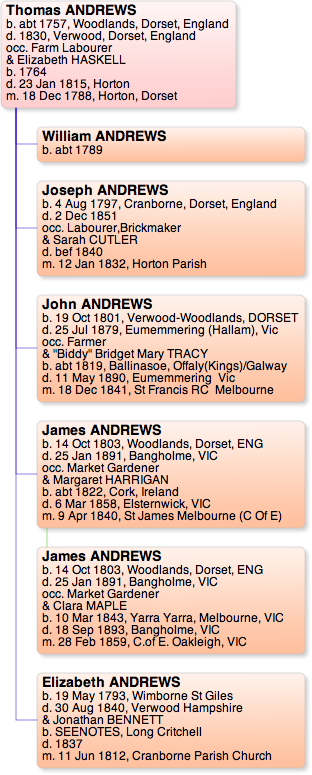 Verwood links Council Verwood Historical society Cranborne Links Cranborne Wikipedia Verwood Wikipedia |
John
and James Andrews were transported aboard the Bengal
Merchant to Van Diemen’s Land (now known as
Tasmania) in 1828. The convict
records from Tasmania show John stole two bags of
wheat rather than the two stocks of bees. James’ record
shows that he also had a bastard child(!). It added they
belonged to a "Gang of Thieves". At about this time
Captain Henry Miller,
of the 40th Regiment, was also in VDL. He was a
g.g.great grandfather of Jeni Andrews.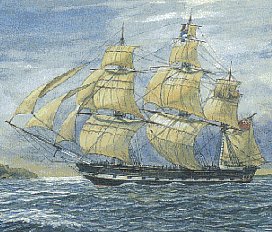 Convicts, on arrival in Van Diemen’s Land, were assigned to settlers as labourers. John was sent to Mr Parramore at Ross as a ploughman. James was sent as a farm labourer to a Mr Batman at Ben Lomond. The same John Batman, seven years later, was involved in the settlement on the banks of the Yarra that was to become Melbourne. If convicts misbehaved they were sent to the road gangs, further problems and they were sent to the gaol at Macquarie Harbour or later Port Arthur. John and James had almost perfect records, unlike many others, and on the 1st March 1834 completed their sentences. They appeared to have stayed on in VDL for the next five years. They may have worked as gardeners for the Fentons. Michael Fenton, and his brothers, were well known property owners of New Norfolk, north of Hobart. Shipping records show several Andrews moving from VDL to Victoria in 1839 and 1840. James and John took land for market gardens at Brighton at this time. James married Margaret Harrigan and John married Bridget (Biddy) Tracy both young Irish immigrants. At about the same time Dendy and his group settled in Brighton, however there seems no connection. J.B.Were, who later founded the prominent stockbroking firm of the same name, was a neighbour. Margaret Harrigan died of consumption in 1858 having no children. In 1859 James married Clara Maple and went on to head a large family. He established market gardens in the Dandenong/Keysborough/Bangholme area. A grandson went on to be the first mayor of the City of Dandenong. John and Bridget were
married at St
Francis
Church
Melbourne on the 18th December 1841
by Father Geoghegan. The town of Melbourne had only
been settled six or seven years at this stage and
Brighton would have been a long journey from the
city. John's farm of 17 acres was on the corner of
Nepean Highway and North Road. Bridget was Catholic as
were the children, however John is said to have
resisted conversion until his deathbed. Father,
later Bishop, Patrick Geoghegan is remembered
for saying the first Catholic mass in Melbourne in
1839. The original timber church was replaced with
the present building some years later. Gold was discovered in the early 1850s and the population of Melbourne exploded. John appears to have been a successful gardener in Brighton and purchased a dairy property at Eumemmering (now Hallam) near Dandenong in about 1854. John and Bridget moved to the Eumemmering place with some of their grown children. John died there in 1879 and in 1881 his son Thomas was appointed administrator of the estate. Bridget died there in 1890 having raised eight children. It was suggested that the family had various properties and were comfortable; however much of this was lost in the financial and property crash of the 1890s. The Brighton property may have been leased out for some years. Of the five sons three married daughters of another Brighton resident, John Straker. He too married an Irish immigrant girl, Mary Boyd. Convict
in
Australia
via Wikipedia |
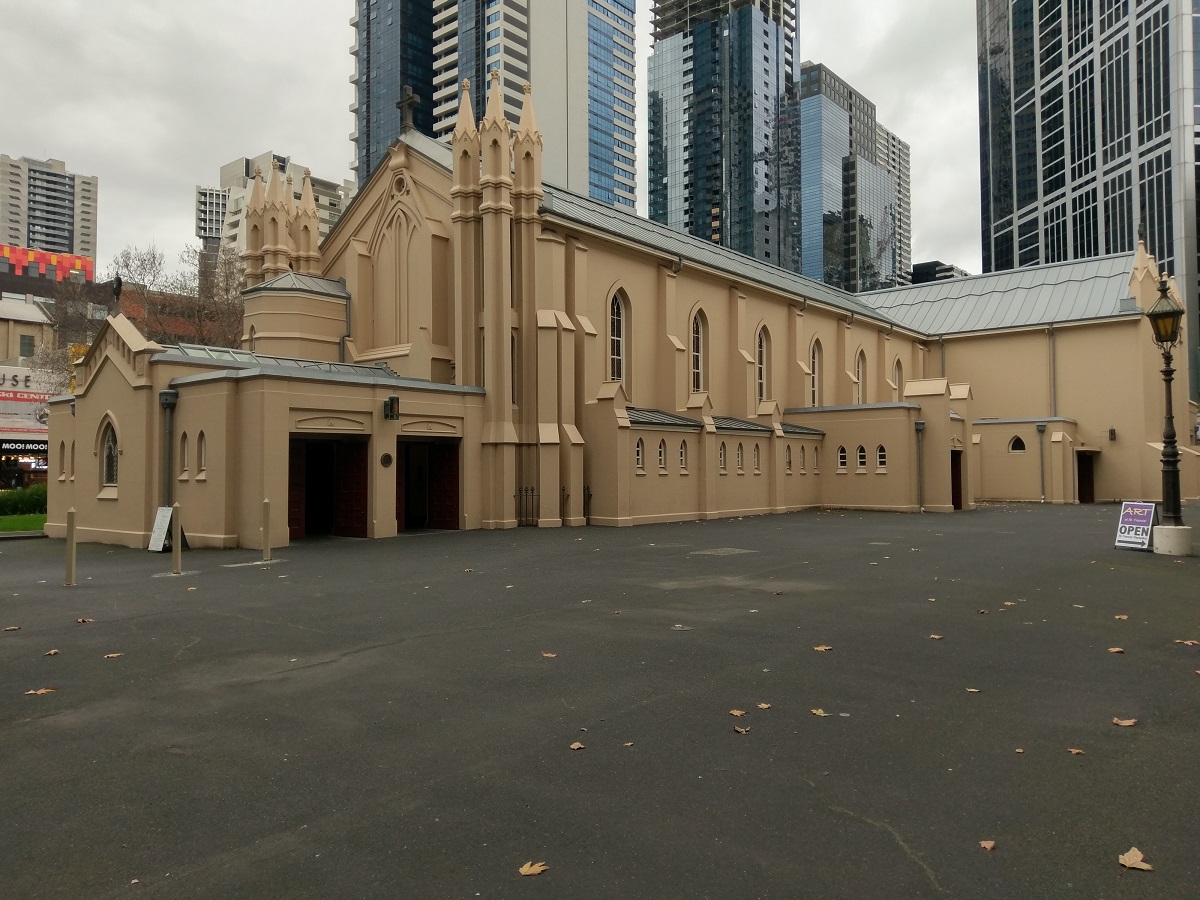
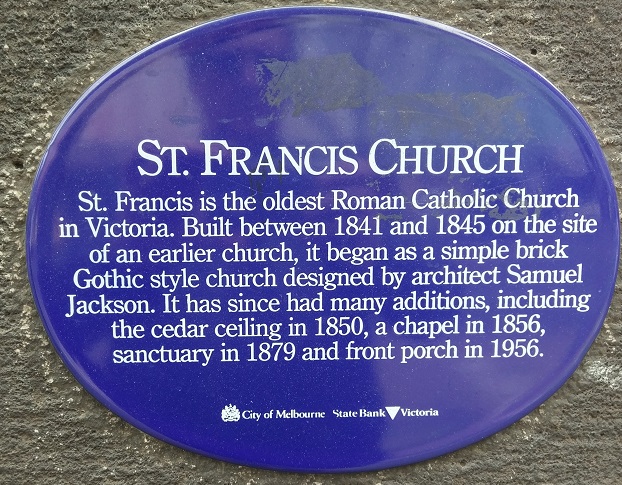
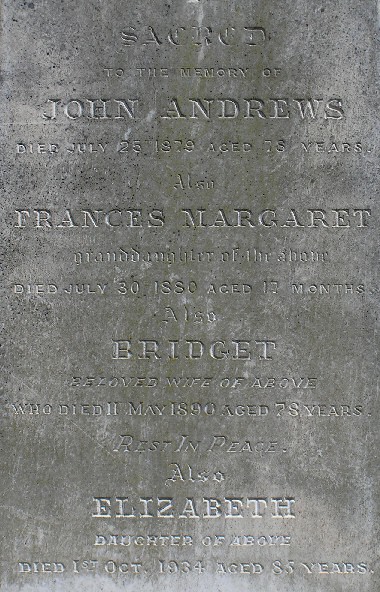
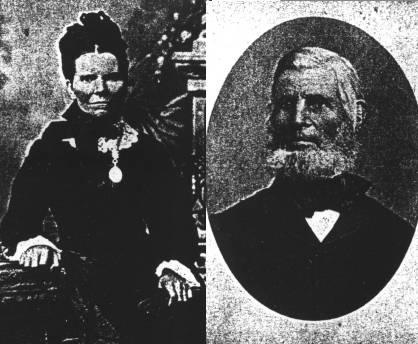
| |
Thomas John
Andrews, married to Mary-Ann Straker, lived
in Bent St Brighton and may have worked for the railways.
John Joseph Andrews was a coal miner. He was the informant of John Andrews’ death in 1879. He died in a mining accident at Coal Creek, Korumburra in 1896. He was severely injured by a coal skip weighing 14 cwt. It was being taken down a grade of 1 in 10 at the time. James William Andrews, the third son, and our ancestor married the third Straker daughter, Elizabeth Frances Straker. See below for detail. Mary Ann Andrews married John Kelly. Their grand daughter, Mary Chapman, remembered well the Hallam property and Auntie Liz from her childhood. ‘The Biddy Tracy Story’, provides the best information we have on the Tracy family. It came from the recollections of Marie Carson, also of this line Elizabeth, ‘Auntie Liz’, second daughter of John and Bridget, lived on at the Hallam (Eumemmering) place until the 1930’s. She never married. The property, a dairy farm, near present Hallam hotel, is now part of an industrial estate. She died Oct. 1934. The pamphlet "A small farm at Hallam: The Andrews 1854 - 1934" by the City of Berwick details her life. Link to Online Version. Google title if link lost. Jane Ellen did not survive infancy Francis Michael Andrews married Margaret Straker in 1883. He and his sister (Elizabeth) purchased the property in Hallam’s road from his father (possibly John's estate). In around 1886 he owned 23 cows, horses and drays, and made 50lbs of butter a week. Harold Hubble is from this line as is Louis Andrews of Granite Rock (near Bairnsdale Vic). Louis suggested that four Straker daughters married members of the Andrews family. He recalls spending happy times in his childhood at the Hallam property with ‘Auntie Liz’. He says that the name Louis comes from a family rumour of association with the French royal family. He says that, contrary to the history books, these stories say that the young Louis escaped France during the revolution. Another child was dressed in his clothes and the young Louis escaped to England. History books say Louis XVI, with his family, tried to escape France in 1791. They were recaptured and he was guillotined in 1793. His son Louis XVII (the Dauphin) died in prison in 1795 aged 10. DNA testing reported in Time Magazine 1st May 2000 confirms this. Frances Sarah (Aunt Fanny), also unmarried, may have lived with, at times, with Elizabeth. She was a tayloress by profession; she traveled and reputedly enjoyed a full social life She also lived in Bay Street Brighton. Later she helped raise the children of John Kelly and Mary Ann Kelly (Andrews) and also the children of John Andrews Kelly. Louis Bernard Andrews, the youngest son, was a coach builder and wheelwright in Footscray during the 1880s. His marital status is unknown. Contact was lost and the family feels he went to the goldfields of West Australia and also South Africa. His death was reported from Woodanilling, WA in 1924. |
| The
family of Bridget Tracy lived in the
counties of Offaly (Kings) and Galway
in Ireland. The town of Ballinasloe
is also mentioned. Bridget was orphaned when her
parents, John and Ellen, died of typhus. She lived in a
convent and with "Aunt Ellen" prior to immigrating. She
arrived in Victoria on the ship ‘England’ in July 1841.
How she met John Andrews is not known. From a text on Irish names I noted the name Tracy has spelling variations, Trassy, Treacy and Tracey. It may have originated from O’Treasaigh. A map shows the name coming from an area of Galway near the border with Offaly. Griffith valuations, a land tax list from the mid 1800's shows fourteen Trac(e)ys in the area The following is the text of a letter written by Marie Carson relating old family stories.. These stories were told by Biddy Tracy Andrews to her children and later retold by Auntie Liz Andrews to my mother Mary Theresa (Kelly) McInnes Dempsey. She had written the notes down about 1950 while her memory was reasonably good. They are rather interesting because the throw some light on the life and times of Biddy Tracy who was later to become the wife of John Andrews. Over a hundred years ago Biddy was the youngest of a family of three girls and one boy living with their parents in the town of Galway. The father was a shipping clerk employed by the Galway Shipping Co. The mother devoted her life to her husband and children. They were not endowed with wealth but lived as comfortable as was possible in those times in Ireland. Then one day their lives were to be completely changed. A storm brought a tremendous shoal of fish upon the shores of Galway Bay. The people were unable to clear the fish fast enough and, as the story goes, the fish began to decay and that in turn caused an outbreak of typhus. Biddy’s parents caught the typhus and died with within hours of each other. The children survived it but soon after the family broke up. The only son took over as a son who was old enough had the power to do in those days in Ireland. He sold up the home and went to sea. The girls were sent into the care of aunts. Biddy was sent off to an Aunt Ellen who had a small farm. There was much work to attend to on the farm. Biddy’s special job, or one of them, was to keep the sow away from the goose that was sitting on eggs. While the goose was sitting on the eggs everything was all right so Biddy lost interest in the gooses eggs and went off picking flowers in the meadow. Then she remembered the goose, she ran back just in time to see the sow eating the last egg. Poor Biddy was frightened of what Aunt Ellen would do to her. Although evening was approaching she ran and got her bonnet and shawl, which they wore in those days, and ran as far as she could from the farm and Aunt Ellen. Night came on, she still ran on not knowing where she was going. At last, exhausted, she stumbled and fell among a flock of sheep. In the early hours of the morning she was found by the shepherd fast asleep among the sheep. This is where this story ends unfortunately we never know what happened to her when she was returned to Aunt Ellen. The other story is some years later. Biddy had been sent to live at a convent. Her brother had come back from his seafaring to visit Biddy in the convent a few times but after that she never heard of him again. She wasn't happy in the convent, life was hard. They had to carry all their water in pails from some distance for washing and other purposes. The other girls in the convent would always think out ways and means of getting out of work and put it all on to Biddy. Then came the time when she heard of immigration to Australia. As they were in need of domestic servants in Australia she made up her mind to immigrate. As the story goes one sister came with her. The elder sister married and may have gone to America. Biddy and her sister, (although there is no record of a sister on the shipping list (see below*) landed in Port Melbourne after six months voyage. Biddy, it was said had many memories of that trip. One of them was the story of one of her cabin mates Mary Ann Slack. The captain came in to the cabin to see if everything was shipshape. But Mary-Ann was lackadaisical. The captain roared at her and said "She was Slack by name and slack by nature." Her name appears on the shipping list with Biddy’s. It was said Biddy always recalled there were English, Irish and Scottish girls on board the ‘England’, all coming to make a new life in Australia even though it did mean hard work for them. The records of the
‘England’, also list as immigrants, Ellen Curley with
her husband Thomas and children John 4, Biddy 18
months and Ann 7. Letters from Edna Chandler of
Picola, a descendant of Ann says that Ann was Ann
Tracy, daughter of Ellen and John Tracy. She added
that Ellen Curley might be the Aunt Ellen mentioned
above. It may well be that Ann was included in the
Curley family group to ensure her passage as an
assisted immigrant. The Curley family settled as
gardeners in the Brighton area. See email below re
Curley. See
shipping records, note Curley seems misspelt as
Codley --------------- We are looking for
the family of ANNE ELIZABETH TRACY who was born on
May 8th, 1817 . Her family originally came
from Glostershire, England--then went to Leinster
and after being on the wrong side of Cromwell , in
the 1600, they were sent to Connaught, Ireland. Ann
married a man named Thomas Gaffy and they raised 10
children in the town of Ballygar in the County of
Galway. Thomas died in 1865 and Ann and her 10
children all came to California, USA. She died
in 1902 in San Francisco. Some distant DNA matches
may support this suggestion Link to TracyClan.com
for further research
|




| James
William Andrews, the third son of John & Bridget
Andrews seems to have stayed on at the Brighton property
when the other members of the family moved to Eumemmering.
His address is shown as Point Nepean Road, Brighton and
occupation noted as gardener, orchardist and fruit grower.
He married the third Straker daughter, Elizabeth
Frances Straker. They raised a family of three girls
and two boys.
James died of pneumonia and heart failure in 1908 aged about 63 years and is buried in Boroondara Cemetery, Kew. Elizabeth moved, at some stage, to St Kilda, and then East Malvern. The two daughters, Cecily Blanche and Elizabeth Grace lived with her. Her unmarried sister Eleanor Straker also lived with them. Elizabeth died in 1932 and is also buried at Boroondara. The children of James & Elizabeth.. Albert
William was born 1879, well educated, possibly
attended Xavier College, Kew, Melbourne. He went on to
work as a clerk and auctioneer. He married Mary-Ann
Hanrahan in 1910 at St. Mary's St. Kilda East. The
marriage was not happy and they divorced in 1924
leaving Mary-Ann to care for the seven children. See
the Hanrahan page for more
detail Albert married Lucy Maud Pill later that year and a child, Lucy Mabel, soon followed. Lucy Pill was the daughter John Pill, a fisherman from Portland. She gave her occupation as ‘domestic’ and had worked with families around Melbourne as a childcare nurse. At some stage Albert worked for the real estate firm of A.E. Lillie and was said to be "the best auctioneer in Melbourne." Lucy and her daughter soon moved back to Portland to live with her family when things did not work out with Albert. This would have been around the start of the great depression and mass unemployment. Albert was thought to have worked "on the roads" around Foster in Gippsland. These were the days of the ‘susso’ or sustenance, the then government arrangements to work on public projects, for a very modest wage. In December 1932 his address was Havelock, a small town near Maryborough in country Victoria. That year Albert issue a caveat on the process of settling his mothers will. The entire estate, valued at about 4000 pounds was going to the daughters. This included two modest houses (700 & 800 pounds) and a parcel of securities. The caveat was removed in 1933 after a settlement of, we think, several hundred pounds. In 1933 his address was 32 Gordon Grove, Malvern. He was in a boarding house in St Vincent's Place, Albert Park in the early 1950’s. The place was sold up or his health was deteriorating and the family was contacted. He was moved to the Home of the Little Sisters of the Poor in Northcote, a nursing home, prior to his death in 1953. There had been no contact with his first family in the intervening years. Cecily Blanche
born in 1880 was also a dressmaker. In 1916 she
married a Charles Henry Nind. He had joined the AIF in
Feb. 1916 and was killed in action in France 1917.
There were no children and she did not remarry. She
and Elizabeth Grace lived with their mother in Malvern
and moved to Glen Iris after their mothers death. She
died in 1959. James Straker Andrews, born in 1881, spent his early years as a seaman around the coast. He married Margaret Egan in about 1905 and following her premature death he married Mary Ann Chartres in 1911. Two children, Kevin and Nellie followed. Elizabeth Grace born
1883, a teacher and dressmaker. She did not marry and
died 1963.
|
| The famous
Gainsborough painting titled Mr & Mrs Andrews is
held in the National
Gallery in London. Check the Wikipedia link for more info Cannot link this family with ours but still trying...
Much of this research
has come from Hilary Burden, Gwendoline Rogers,
June Brown, Damian Smith , Marie Carson, Mary
Chapman, Lola Marsh, Harold Hubble, Edna Chandler,
Rosemary (Andrews) Morison, Keith Bennett
and many others.
|
| Hi I am a descendent of the Ferretts of Verwood who owned the pottery for years. I think too that I might be connected to your family tree. I have a George Andrews and a Mary Elizabeth Andrews on my Ferrett family tree who were brother and sister, George married Kitty/Kate ferrett who was born in 1857 and had a son Walter Harry Cutler Andrews, and Thomas and Mary married Frederick Ferrett in 1884. Their parents were Joseph and Elizabeth. Apparently Joseph and Elizabeths memorial stone also bears an inscription to Kitty or Kate. I've been studying your family tree and I think that that Joseph and Elizabeth could have been the son and daughter in law of Joseph and Sarah Cutler. Would you be able to shed any light on this? Also are they related do you know to the Andrews that currently own the butchers shop in Verwood? |
||
|
My maiden name was
Straker and I am doing some research into our side of
the family tree. From what I can see so far there
seem to be three groups of Strakers in England and we
belong to the London ones that lived around
Islington. My Grandfather, Frederick Charles, came
to Australia in the early 1900's via India and one of
his brothers, Robert, went to Canada where there is now
another group of Strakers.
What really excited me
was the fact that your Straker ancestor lived just down
the road from my Head (my Mothers side) relative in
Brighton. They bought land to farm bounded by
North Road and Hodder Street which is just up from where
you say John Straker lived. William and Sarah Head
were Methodists and built the first Methodist church so
I suppose the opposing religions would be one reason why
there was no intermarriage. They lived there from 1839
and had a large family. Ferntree Gully Road used
to be called Heads Road.
|
||
Hi Peter, |
||
|
Dear All, I have found
your fabulous web site through Genseek - Convicts
etc., Haven't read it all, but you have
produced a wonderful document. My interest
is the reference to one family living opposite St.
Finbars Catholic Church - corner of Point Nepean Road
and Centre Road, Brighton, but which corner? This
is the area where I grew up and at one stage there was a
Garage - shops etc., and houses which were not very old
compared with others nearby - this was the north-west
corner. (these shops etc. have all been demolished
for the widening of the Nepean Highway) It is an
eerie feeling that these people you are writing about,
walked around the same area. Wouldn't we
love to meet them now and have a chat and a cup of
tea!!!!!
Another convict story I
have been following is of Samual Pyers (Active) and
Sarah Johnson (Britannia 11). One
family of their descendants, who are
friends of mine, lived on the Point Nepean Road, East
Brighton, close to Centre Road.
I am always very
interested and grateful to have access to these
wonderful tales posted on
the 'net'.
My congratulations,
regards, Valma
|
||
Greetings, |
||
|
I have just come across your Andrews
site and see Elizabeth Amey and your reference to Horton
With Woodlands and also the Cutler name..
My GG Grandmother was Catharine Amey, she had a son
Elijah Louis in 1808 in Horton with Woodlands, no father
was listed.
She must have been born c1790 but I have failed to
find any other trace of her except her marriage in 1820
to John Frampton also in Horton with Woodlands and both
were from Woodlands.
Later in 1831 Elijah married Hannah Cutler in Horton
with Woodlands, he listed Thomas Amey as his father?
Elijah move to Poole and finally to Upham
Hampshire.
The Haskell name has cropped up many times in
Amey trees but with no direct links yet to my tree.
Dorset OPC has suggested that Catharine could have
been baptized Elizabeth but used Catharine.
Horton is such a small area but I have yet to make
any links
Love to hear your thoughts on this.
Carolyn Amey
|
||